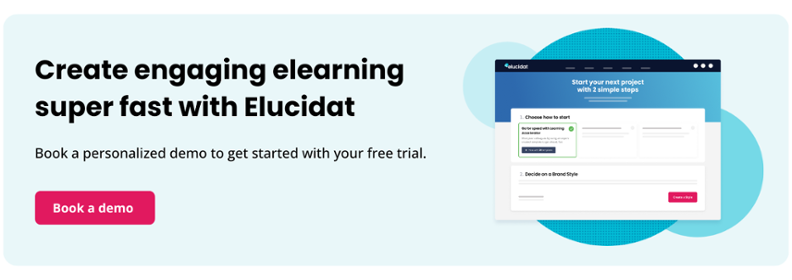Points, levels, and rewards
Bring elearning to life by taking inspiration from some of the classic features of video games:
- Let learners earn points for correctly answering questions, with a running total displayed on-screen.
- Give rewards for milestones like passing tests or completing content—think virtual badges, trophies, or even cosmetic features for avatars.
- Trigger a level-up when learners reach certain points thresholds, unlocking new powers, extra content, or helpful hints.
See how points and rewards can elevate a simple quiz in this example:
Competition
Make gamification multiplayer by introducing some friendly competition – and a sense of social interaction to boot. Use leaderboards to position learners by points or progress, sparking motivation to climb the ranks.
Or keep competition more low-key by incorporating social feedback to show how peers performed on tasks, like in this sales simulation training:
Pressure
Beat learner complacency by raising the stakes and cranking up the difficulty as they progress. Make activities increasingly more challenging. Or introduce a countdown timer to sharpen focus and keep attention locked in.
As the challenge grows, so can the rewards. Check out this example of a round-based learning quiz, where tougher questions mean more points up for grabs:
Mistakes to avoid when using gamification
The biggest mistake in gamification? Slapping on game mechanics with no real purpose. If you’ve ever suffered through a corporate training ‘game’ that felt pointless, you get it.
Gamification should enhance your content, not just sit on top as fluff.
Avoid these common pitfalls:
- Irrelevant gamification: A health and safety Tetris mashup? Probably not the best idea. Align the game with the content instead.
- Random rewards: Points and achievements should serve a purpose. If they don’t contribute to the bigger picture, they’re just noise.
- No feedback: Learners should always understand why an answer is right or wrong. Clear feedback helps them improve and stay engaged.
Best practices for applying gamification to elearning
Get gamification right with these three simple steps:
- Decide if it fits
Gamification isn’t always the answer. Super serious subject matter? Time-pressed learners looking for quick info in a pinch? It’s probably better to skip gamification and save it for when it truly adds value.
- Plan the game mechanics
Map out exactly how your gamified elearning will work. Consider everything, including your authoring tool, activity types, and game mechanics. Features like rewards and levels need logic behind them. Use a spreadsheet to do the math for a seamless learner experience.
- Think like your learner
Don’t get so caught up in the mechanics that you forget who you’re designing for. Ask yourself:
- Is the gameplay challenging but not frustrating?
- Does progress feel meaningful?
- Is the learning experience smooth and engaging?
Always keep the learner’s experience front and center. And, most importantly, test, test, test to check everything works as it should.
Common gamification challenges and how to fix them
The course of gamification doesn’t always run smooth. But that won’t be your fate if you use these strategies to overcome common challenges:
- Problem: Gameplay is too easy – or too hard
- Solution: Test with real learners before launch. If in doubt, start simple and gradually dial up the difficulty to keep things interesting.
- Problem: Game features feel random
- Solution: Make them matter. Tie game mechanics to learning goals. Skip generic point scoring and design missions that mirror real-life situations.
- Problem: Points and reward system melting your brain
- Solution: Calculate the maximum and minimum possible scores. Then work backward to set fair reward thresholds.
- Problem: Learners don’t understand how to play
- Solution: Guide them with clear instructions whenever introducing new game features. If in doubt, over-explain rather than leaving them guessing.
Applying gamification to other types of learning
Elearning often springs to mind when we think of gamification. But non-digital learning can benefit from gamification strategies too.
Check out these ideas for game-based learning, whatever the context:
- Create competition: Split learners into teams for a pop-quiz, problem-solving activity, or race to find answers. Throw in a token prize for extra motivation.
- Set micro-challenges: Assign small daily learning tasks, like ‘find out how to…’ and reward with stamps or points. You could add a leaderboard to amp up engagement.
- Make it hands-on: Focus on the exploratory side of gameplay by designing role-playing scenarios or escape-room-style challenges that encourage teamwork and problem-solving.
Conclusion
When it comes to increasing learner engagement, gamification packs a serious punch. With countless ways to incorporate game elements in both online and real-world learning, the possibilities are endless.
Just be sure to plan carefully to ensure gamification is more than just the proverbial cherry on top.
Want more tips on getting the most out of gamification in your digital learning content? Download the ultimate guide for elearning best practice or take this course on creating engaging elearning.
Looking for an elearning authoring platform that makes gamification easy? Try Elucidat. Book a demo and start your own game design with a free trial.





